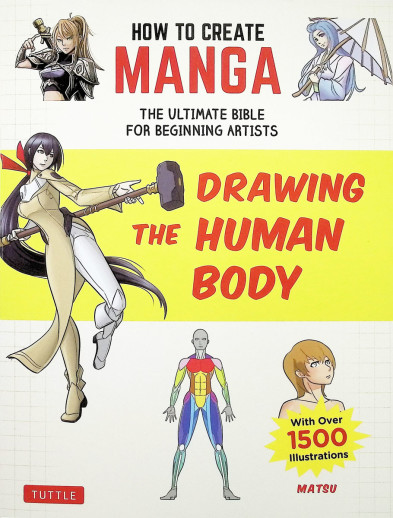We use cookies to make your experience better. To comply with the new e-Privacy directive, we need to ask for your consent to set the cookies. Learn more.
How to Create Manga Drawing the Human Body
This is like a simplified anatomy catalog for artists – and it can be used for many styles of drawing, not just manga. At its core, this book breaks down the structure of bodies, facial features, and hair and shows you how to use that. You won't find draw with me step-by-step characters or advice on creating storylines. Instead, you'll find detailed diagrams of each part of the body and how to portray them in a drawing, and LOTS of proportions. Each section starts with basic ratios, then progresses to how to draw specific features using their proportions and muscular structure. For artists who prefer to draw digitally, there are also “digital tool" sections that explain a bit about how to color/sketch in various programs. As someone who's taken formal figure drawing classes and studied anatomy from an artist's perspective, my favorite part of this book is the unique way the muscle structures are depicted. Drawing the human body is difficult, and full, anatomically accurate muscle and bone structures can create quite a muddle. Which muscles would actually show through the skin or be emphasized in certain positions? How many bones do I really need to build up a convincing figure? By color-coding different sections of muscles and showing those used in a sketch, this book makes all that information much more approachable. This book isn't for everyone – given its matter-of-fact style and extreme focus on structure and proportions, true beginners will likely be intimidated, and those who don't focus well may be overwhelmed. However, in the hands of someone who's put pencil to paper a few times, it could become a much-utilized reference. (Note: Though not “anatomically correct", there are sections on how to draw breasts, pelvic areas, and buttocks.) 176 pgs, pb.
Manga artists of every level will benefit from this essential anatomical overview. Step-by-step instructions bring manga characters to life and provide a clearly defined and easy-to-follow art course on the human body. With more than 1,500 highly-detailed drawings and useful tips from a manga artist actually working in the business, this book is a self-contained art class in a single volume.
In this book, the body is covered head-to-toe—from various angles and positions with versions for men, women and children all provided. How to Create Manga: Drawing the Human Body is a must-have for budding manga artists and an essential reference for experienced artists looking to hone their ability to draw certain parts of their characters with greater accuracy.
Tuttle's How to Create Manga series guides users through the process of reaching a professional-looking final drawing through actual sketch progressions, practical tips and common missteps to avoid. Other books in the series include How to Create Manga: Drawing Facial Expressions, How to Create Manga: Drawing Clothing and Accessories and How to Create Manga: Drawing Action Scenes and Characters.
| Product Format: | Paperback |
|---|---|
| Brand: | Tuttle Publishing |
| Grades: | 8-AD |
| ISBN: | 9784805315613 |
| Length in Inches: | 10 |
| Width in Inches: | 7.625 |
| Height in Inches: | 0.5625 |
| Weight in Pounds: | 1.6 |

